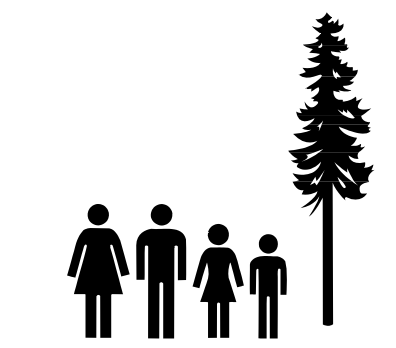
Resources for Small Woodland Owners
Organizations and collaborations, networks and individuals, classes and workshops, on-site and on-line: there are a multitude of resources to assist small forestland owners in the process of refining their objectives for their property and then bringing them to life.
The Partnership for Forestry Education is a collaboration of state, federal and private organizations to provide educational resources to Oregon's forest landowners, managers and operators. The Partnership was created to overcome decreases in key state agency budgets that reduced their capacity to provide the necessary educational programming. Partnership activities include jointly planned and delivered educational programs, a partnership web site, a shared database, joint outreach mailings and increased use of the knowledge delivered.
The Committee for Family Forestlands
The role of the CFF is to advise the Board of Forestry and the State Forester on matters relating to family forestlands. Four of its seven voting members are small landowners from the Oregon Department of Forestry’s three administrative districts and one at-large. Meetings are held quarterly and are open to the public, both in person and virtually. Each year, the CFF appears before the Board of Forestry to provide an annual report on its work and key areas of concern to family forest landowners.
Meetings for 2025: January 22 | March 19 | June 18 | September 17
Other Landowner Resoures
-

Resources for Family Forest Landowners
In Oregon, there are many sources of assistance available to forest landowners: expert technical advice, classes, grants and person-to-person counsel from peers – as well as online resources. This guide organizes these resources geographically and in other logical ways, for easy reference. Throughout the booklet are descriptions of each resource as well as handy contact information. Updated for 2024-2026.
Developed by OFRI in cooperation with the Partnership for Forestry Education.
This publication (as well as many others) an also be ordered (free) from the OFRI website.
-

Oregon Forest Protection Laws: An Illustrated Manual
Since it was first published in 2002, Oregon’s Forest Protection Laws: An Illustrated Manual has become a standard reference for those planning and executing timber harvests. The publication fosters easy understanding of the Oregon Forest Practices Act and Rules, and the other best management practices, laws and rules that apply to Oregon’s forest landowners.
This Revised Fourth Edition was necessary following major changes to the Forest Practices Act resulting from the Private Forest Accord agreement between the timber industry and environmental groups. This includes new rules regarding riparian management, logging on steep slopes, and forest road construction and maintenance.
This edition is available both as a PDF and a spiral bound book.
-

Oregon Forest Management Planning
A resource for landowners and foresters
Are you thinking about writing a forest management plan? This site will guide you and your forestry professional to all the resources you’ll need. Get started by navigating the pages below and using the Unified Management Planning Templates.
-

Tree School Online
The OSU/Partnership for Forestry Edfucation Tree School Online series ran from March 2020 - April 2022 featuring 52 webinars of favorite Tree School classes. Check out this Tree School Online library for a wide variety of learning opportunities, including webinar recordings and resources from instructors.
-

Know Your Forest
An educational website for Oregon Forest Landowners.
This website is a tool for the small forest landowners of Oregon. It was created by the Partnership for Forestry Education, a collaboration of state, federal and private organizations. We hope this website is your gateway to the educational opportunities that will help you really Know Your Forest
-

Landmapper
Welcome to Landmapper, a simple online tool to create maps of your property you can quickly save, download, or print.
Landmapper is designed to help make conservation and management planning easier for forest owners.
We currently offer maps across Oregon including aerial photos, street maps, topography, streams, and soil types.
-

Woodland Fish & Wildlife
Want to Improve Wildlife Habitat on Your Forest Land?
The Woodland Fish and Wildlife publication series is for you. A variety of practical “how to” publications are written just for small forest owners in the Pacific Northwest. All publications are free and can be downloaded from the list below.
-

Family Forests of Oregon YouTube Channel
OSWA & OTFS share a YouTube channel! From county Tree Farmer of the Year videos to a Forestry Taxation series, there are lots of options for videos to watch and things to learn. Check it out—and consider subscribing while you’re there!
-

Introduction to Forest Carbon, Offsets and Markets
This publication will introduce readers to forest carbon, carbon offsets, projects and markets. It is intended to orient forest owners, land managers, natural resource professionals and others to forest carbon and
carbon market terminology and processes, as well as resources for assistance and getting started.Jacob D. Putney, Norma Kline, Stephen Fitzgerald, Lauren Grand, Chris Schnepf, Greg Latta, Patrick Shults and John Rizza
-

Ties to the Land: Succession Planning for Rural Landowners
Many small landowners across the nation are reaching retirement age and are wondering how they can and should pass on their land or associated business. This conundrum is not unique to the Pacific Northwest.
Whether you own a farm, forest or rangeland, you care about your property and what happens to it. That's why you need a succession plan to help guide its transition to future owners. Ties to the Land helps you think through the social, financial and legal aspects of succession. Worksheets help you refine your goals, take stock of assets and sketch out a timeline, while case studies bring the lessons home.
Note: Reach out to your local OSU Extension forester to see when the next Ties to the Land workshop will be held.


